AG Carinae (HD 94910) is a luminous blue variable (LBV) located approximately 17,000 light-years away in the southern constellation Carina (the Keel). With an apparent magnitude that varies between 5.7 and 9.0, the star is mostly invisible to the unaided eye.
AG Carinae is one of the most luminous stars known in the Milky Way galaxy. It has an energy output 600,000 – 900,000 times that of the Sun. Like its better-known neighbour Eta Carinae, it will end its life as a bright supernova.
Star type
AG Carinae is a luminous blue variable star (LBV) that is currently undergoing a transition between a massive O-type supergiant and a Wolf-Rayet star. It has a mass 55 times that of the Sun and a radius of 50 – 500 solar radii. With an effective temperature that varies between 8,000 and 26,000 K, the star shines with 600,000 – 900,000 solar luminosities.
AG Carinae is only a few million years old, and it is not expected to live longer than 5-6 million years due to its high mass. Like other stars in this class, it is highly unstable and losing mass at an exorbitant rate.
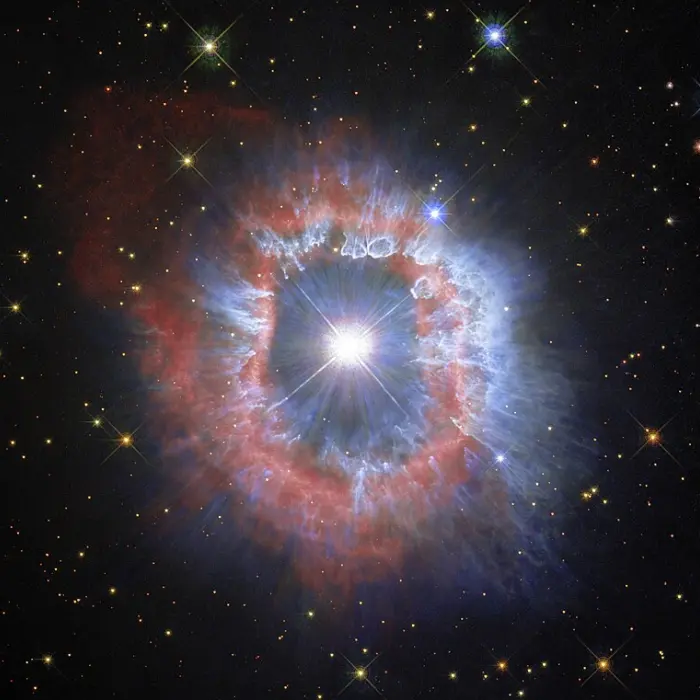
This image showcases views of the dual nature of the star AG Carinae, which was the target of the NASA/ESA Hubble Space Telescope’s 31st anniversary image in April 2020. This new perspective was developed thanks to Hubble’s observations of the star in 2020 and 2014, along with others captured by the telescope’s WFPC2 instrument in 1994. The first image showcases the details of the ionised hydrogen and ionised nitrogen emissions from the nebula (seen here in red). In this image, the blue demonstrates the contrasting appearance of the distribution of the dust that shines of reflected stellar light. Astronomers believe that the dust bubbles and filaments formed within and were shaped by powerful stellar wind. This giant star is waging a tug-of-war between gravity and radiation to avoid self-destruction. The nebula surrounding the star is about five light-years wide, equal to the distance from here to our nearest star, Alpha Centauri. AG Carinae is formally classified as a luminous blue variable because it is hot (blue), very luminous, and variable. Such stars are quite rare because there are not many stars that are so massive. Luminous blue variable stars continuously lose mass in the final stages of their life, during which a significant amount of stellar material is ejected into the surrounding interstellar space, until enough mass has been lost that the star has reached a stable state. AG Carinae is surrounded by a spectacular nebula, formed by material ejected by the star during several of its past outbursts. The nebula is approximately 10 000 years old, and the observed velocity of the gas is approximately 70 kilometres per second. Image credit: ESA/Hubble and NASA, A. Nota, C. Britt CC BY 4.0
Luminous blue variables are massive, luminous supergiant or hypergiant stars that experience instability and exhibit a wide range of spectroscopic and photometric variations. Fewer than 50 LBVs are known to exist in the Local Group of galaxies. These stars are quiescent for extended periods and then they undergo periodic outbursts and occasionally more dramatic eruptions to maintain stability.
AG Carinae shows erratic variations in brightness between magnitude 5.7 and 9.0. It experiences irregular pulsations, as well as occasional outbursts.
The star expands and contracts as a result of radiation pressure pushing outward from its core and gravity pressing inward at the same time. When the outward pressure is stronger, the star grows to an immense size and casts off its outer layers. Larger outbursts only happen when the star is in danger of going out as a supernova. After the outbursts, it returns to its quiescent state and shrinks to its normal size.
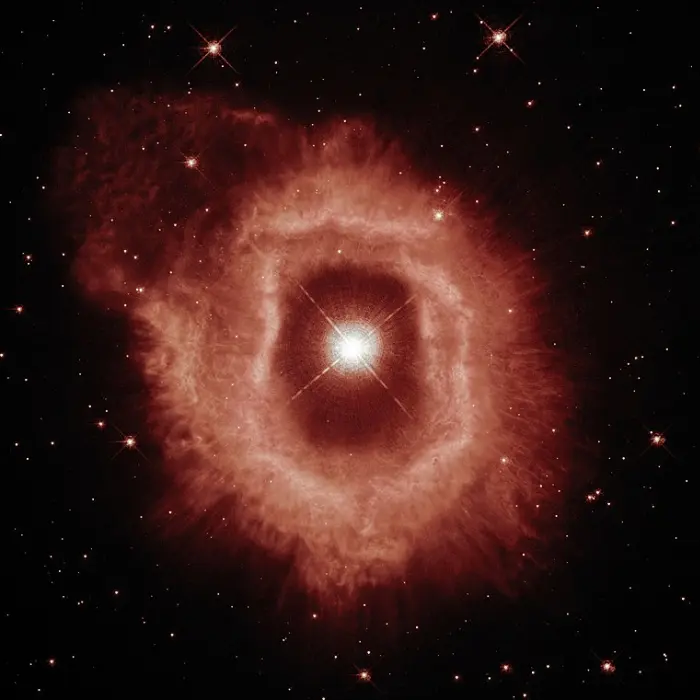
This comparison view shows puffing dust bubbles and an erupting gas shell— the final acts of a monster star. The gas is visible to us in these images as a thick bright red ring, which appears doubled in places — possibly the result of several outbursts colliding into each other. The dust, here visible in blue, has formed in clumps, bubbles and filaments that are shaped by the stellar wind. Scientists who observed the star and its surrounding nebula note that the ring is not perfectly spherical; it appears to have a bipolar symmetry, indicating that the mechanism producing the outburst may have been caused by the presence of a disc in the centre, or that the star is not alone but might have a companion (known as a binary star). An alternative and simpler theory is that the star rotates very fast (as many massive stars have been found to do). Image credit: ESA/Hubble and NASA, A. Nota, C. Britt (CC BY 4.0 DEED)
Luminous blue variables are also known as S Doradus variables, after the class prototype S Doradus in the Large Magellanic Cloud. Other examples of this class include Eta Carinae and HR Carinae in the constellation Carina, V4029 Sagittarii in Sagittarius, P Cygni in Cygnus, V1672 Aquilae in Aquila, V905 Scorpii in Scorpius, and Westerlund 1-243 in Ara. The Pistol Star and the Peony Star in Sagittarius are also suspected LBVs.
At its faintest, AG Carinae has the spectral class WN11 and, at it brightest, it appears as an early A-type hypergiant. The star experiences dramatic changes in radius. At visual minimum, it has a radius of about 65 solar radii and a surface temperature of 20,000 – 24,000 K and, at maximum, it grows to a size of over 400 solar radii and has an effective temperature of 8,000 K.
While luminous blue variables typically have constant bolometric luminosity during outbursts, the luminosity of AG Carinae drops from 1.5 million solar luminosities at visual minimum to about 1 million solar luminosities at visual maximum. This may be due to the amount of energy needed to expand the star’s outer layers. These layers are believed to have a mass of 0.6 – 2 solar masses.
AG Carinae spins with a projected rotational velocity of about 220 km/s and completes a rotation every 13 or so days. Evolutionary models indicate that the star was a slow spinner for most of its life even though it now seems to spin quite rapidly.
The hot blue star is surrounded by a nebula of expelled material. The halo of dust and gas has an inner radius of 1.3 light-years (0.4 parsecs) and an outer radius of 3.9 ly (1.2 pc). It looks like a ring, but it is really a hollow shell of dust and gas shaped by the star’s powerful stellar wind.
The nebula surrounding AG Carinae has about 15 solar masses of material that was ejected from the star during an outburst about 10,000 years ago. Powerful stellar winds cleared a cavity 28.7 light-years (8.8 parsecs wide) around the star in an earlier stage of evolution. The gas in the nebula is composed mostly of ionized hydrogen and nitrogen.
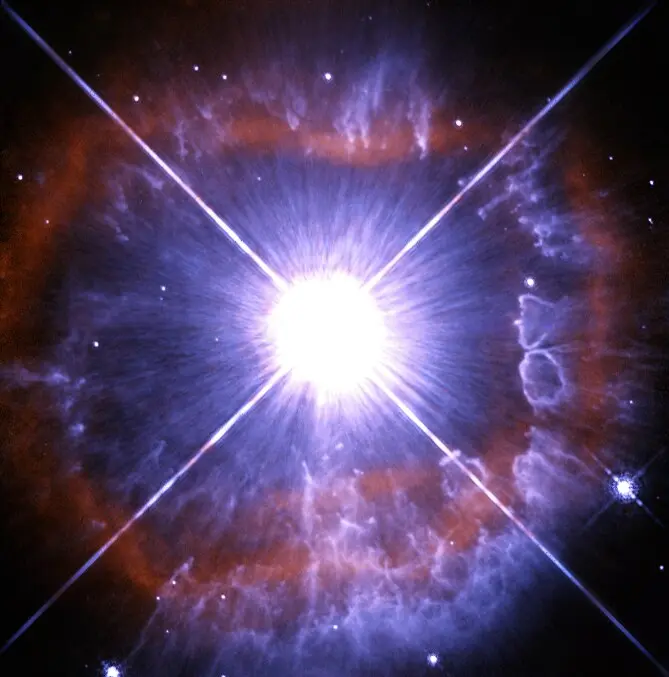
AG Carinae is classified as a luminous blue variable. These rare objects are massive evolved stars that will one day become Wolf-Rayet stars — a class of stars that are tens of thousands to several million times as luminous as the Sun. They have evolved from main sequence stars that were twenty times the mass of the Sun. Stars like AG Carinae lose their mass at a phenomenal rate. This loss of mass is due to powerful stellar winds with speeds of up to 7 million km/hour. These powerful winds are also responsible for the shroud of material visible in this image. The winds exert enormous pressure on the clouds of interstellar material expelled by the star and force them into this shape. Despite HD 94910’s intense luminosity, it is not visible with the unaided eye as much of its output is in the ultraviolet. This image was taken with the Wide Field and Planetary Camera 2 (WFPC2) aboard the Hubble Space Telescope. Image credit: ESA/Hubble & NASA (CC BY 4.0 DEED)
Facts
AG Carinae is believed to have had an initial mass of around 100 solar masses. It has lost a good portion of it as it evolved away from the main sequence and now has an estimated mass of 55 – 70 solar masses. Even though it is a very young star, it is not known to be associated with any hot, massive O-type stars that lie at a similar distance.
Studies that used modelling for luminous blue variables that are candidates for type IIb supernovae indicate that the spectrum of AG Carinae corresponds to the spectra of supernova progenitors just before core collapse. However, the studies used models for stars with masses 20 to 25 times that of the Sun.
The distance of AG Carinae is still uncertain. The star was once thought to lie 19,569 light-years (6,000 parsecs) away. However, the Gaia Data Release 1 (Gaia DR1) data indicates that the star and its neighbour Hen 3-519 lie approximately 6,523 light-years (2,000 parsecs) away. This would mean that the stars are not as luminous as LBVs, but rather that they are former red supergiants with unusual features resulting from binary evolution. However, a 2017 study suggested that the distance is 2.50 ± 1.41 kiloparsecs. Based on the parallax obtained in Gaia Data Release 2 (Gaia DR2), AG Carinae lies 6,500 parsecs away, while a 2019 study gives a value of 4,650 parsecs.
AG Carinae is catalogued as WR 31b, while its visual neighbour Hen 3-519 is catalogued as WR 31a. While some studies placed the stars at a similar distance, more recent studies suggest that Hen 3-519 is much further away. Hen 3-519 is believed to lie 28,000 light-years away. It has a mass of about 17 solar masses and a luminosity of 1,820,000 Suns. The star is surrounded by a Wolf-Rayet nebula about 7.8 light-years across. It is a candidate luminous blue variable.
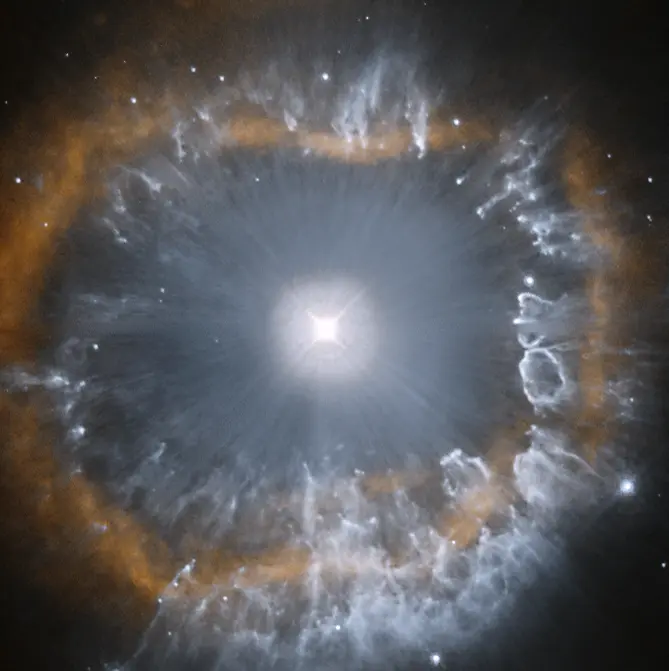
AG Carinae, image credit: Judy Schmidt, Hubble Legacy Archive (CC0 1.0 DEED)
Name
AG Carinae does not have a proper name. As it is barely visible even at its brightest, the star has never had a traditional name. AG Carinae is a variable star designation, an identifier based on the Bayer designation scheme. Variable stars have identifying labels that consist of one or two Latin letters (i.e. VY Canis Majoris, UY Scuti, VX Sagittarii) or the letter V and a number (i.e. V603 Aquilae, V340 Andromedae, V396 Persei).
Location
AG Carinae lies in the region southwest of the Southern Cross and northwest of the Diamond Cross. It appears roughly halfway between Mimosa in the Southern Cross and Markeb in the False Cross (or between Gacrux and Aspidiske).
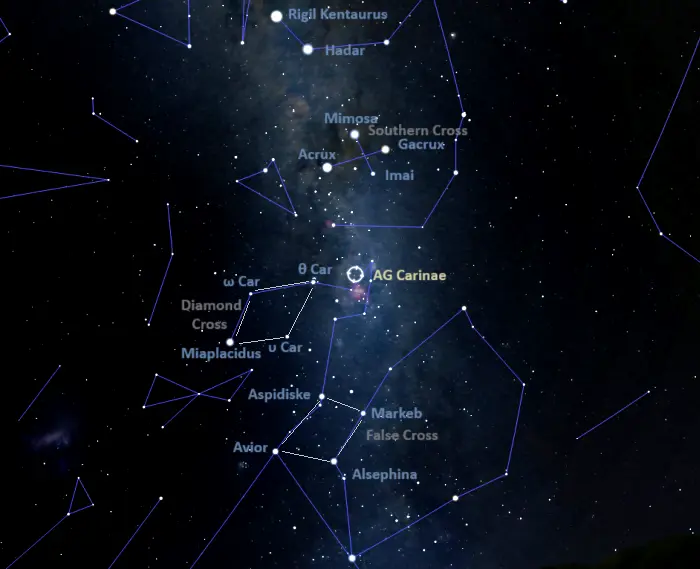
The location of AG Carinae, image: Stellarium
The star appears in the area between four exceptionally bright deep sky objects: the Carina Nebula (NGC 3372), the Theta Carinae Cluster (Southern Pleiades, IC 2602), the Lambda Centauri Nebula (Running Chicken Nebula, IC 2944), and the Wishing Well Cluster (NGC 3532).
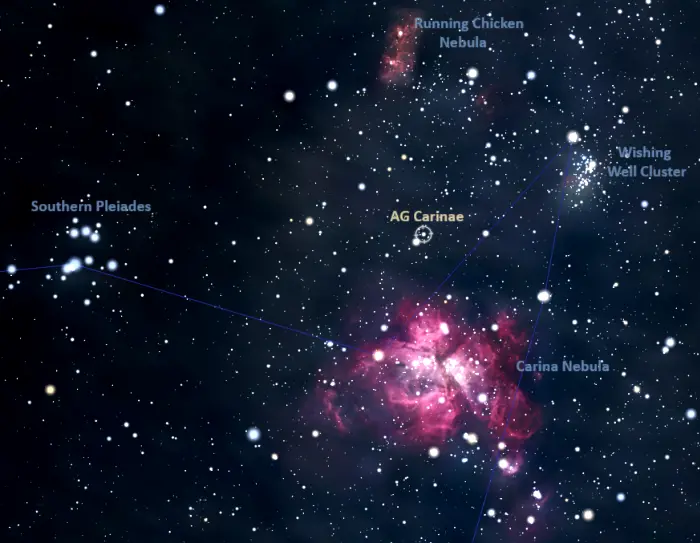
AG Carinae location, image: Stellarium
Constellation
AG Carinae is located in the constellation Carina. In Greek mythology, Carina represents the keel of the ship Argo, on which Jason and the Argonauts sailed to Colchis on their quest to get the Golden Fleece. It formed the obsolete constellation Argo Navis (the Ship Argo) with the neighbouring constellations Vela (the Sails) and Puppis (the Stern).
Argo Navis was one of the Greek constellations, catalogued by the Greco-Roman astronomer Claudius Ptolemy in the 2nd century CE. It was divided into the three smaller constellations the French astronomer Nicolas-Louis de Lacaille in the 18th century.
Carina is the 34th largest of the 88 modern constellations. It occupies 494 square degrees of the southern sky. With six stars brighter than magnitude 3.0 – including the navigational stars Canopus, Miaplacidus, and Avior – it is one of the brightest southern constellations. Canopus, the constellation’s brightest star, is the second brightest star in the sky (after Sirius).
The constellation’s three brightest stars are all evolved stars; Canopus is a bright giant and Miaplacidus and Avior are giants. Miaplacidus forms an asterism called the Diamond Cross with Theta, Upsilon and Omega Carinae, and Avior is part of the False Cross, along with the white supergiant Aspidiske in Carina and Alsephina and Markeb in Vela.
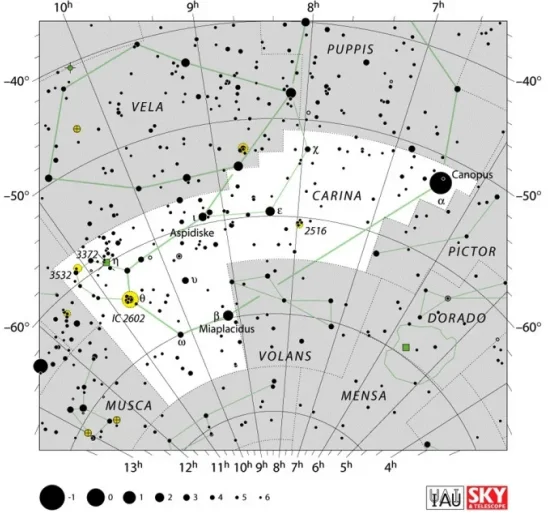
Carina constellation map by IAU and Sky&Telescope magazine
Carina is also home to the famous luminous blue variable Eta Carinae, the brightest star in the Carina Nebula, the Mira variables S Carinae and R Carinae, and the variable giant q Carinae.
The best-known deep sky objects in Carina are the Carina Nebula, a vast star-forming region that lies about 8,500 light-years away, the Southern Pleiades (the Theta Carinae Cluster, IC 2602), the Southern Beehive Cluster (NGC 2516), and the Wishing Well Cluster (NGC 3532). Other deep sky objects in Carina include the Statue of Liberty Nebula (NGC 3576), the Gem Cluster (NGC 3293), the open cluster NGC 3114, the globular cluster NGC 2808, and the Bullet Cluster, a pair of merging clusters of galaxies located approximately 3.7 billion light-years away.
The best time of the year to see the stars and deep sky objects in Carina is during the month of March, when the constellation is high above the horizon in the evening. The entire constellation is visible from locations south of the latitude 20° N.
The 10 brightest stars in Carina are Canopus (Alpha Car, mag. -0.74), Miaplacidus (Beta Car, mag. 1.69), Avior (Epsilon Car, mag. 1.86), Aspidiske (Iota Car, mag. 2.21), Theta Carinae (mag. 2.76), Upsilon Carinae (2.97), Omega Carinae (mag. 3.29), PP Carinae (p Car, mag. 3.22 – 3.55), V337 Carinae (q Car, mag. 3.36 – 3.44), and V357 Carinae (a Car, mag. 3.41 – 3.44).
AG Carinae
| Spectral class | LBV or WN11h |
| Variable type | Luminous blue variable (LBV) |
| U-B colour index | −0.58 |
| B-V colour index | +0.61 |
| Apparent magnitude | 6.96 (5.7 – 9.0) |
| Absolute magnitude | ~−8 (at minimum) |
| Distance | 17,000 ± 1,000 light-years (5,200 ± 400 parsecs) |
| Parallax | 0.1925 ± 0.0165 mas |
| Radial velocity | -54 km/s |
| Proper motion | RA: −4.808 ± 0.018 mas/yr |
| Dec.: +1.955 ± 0.018 mas/yr | |
| Mass | 55 M☉ |
| Luminosity | 600,000 – 900,000 L☉ |
| Radius | 50 – 500 R☉ |
| Temperature | 8,000 – 26,000 K |
| Rotational velocity | 220 ± 50 km/s |
| Rotation | 13 ± 2 days |
| Constellation | Carina |
| Right ascension | 10h 56m 11.5781414448s |
| Declination | −60° 27′ 12.810673260″ |
| Names and designations | AG Carinae, HD 94910, HIP 53461, SAO 251185, CD–59°3430, CPC 20.1 2994, AAVSO 1052-59, WR 31b, PPM 358343, GC 15044, GCRV 27197, LS 2035, JP11 2012, GSC 08958-03996, UBV M 16671, UCAC3 60-139962, UCAC4 148-068243, IRAS 10541-6011, 2MASS J10561158-6027128, TYC 8958-3996-1, CEL 3763, LLNS 3351, MWC 216, SPH 113, Gaia DR1 5338220281038746112, Gaia DR2 5338220285385672064, Gaia DR3 5338220285385672064, PK 289-00 1, ESO 128-21, Hen 2-58, Hen 3-528, SCM 59, WRAY 15-693 |
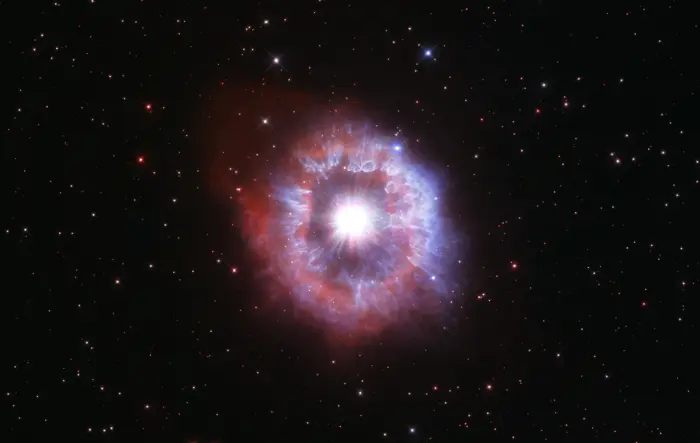
In celebration of the 31st anniversary of the launching of NASA’s Hubble Space Telescope, astronomers aimed the renowned observatory at a brilliant “celebrity star,” one of the brightest stars seen in our galaxy, surrounded by a glowing halo of gas and dust. The price for the monster star’s opulence is “living on the edge.” The star, called AG Carinae, is waging a tug-of-war between gravity and radiation to avoid self-destruction. The expanding shell of gas and dust that surrounds the star is about five light-years wide, which equals the distance from here to the nearest star beyond the Sun, Proxima Centauri. Major outbursts such as the one that produced the nebula occur once or twice during a luminous blue variable’s lifetime. Because of their massive forms and super-hot temperatures, luminous blue variable stars like AG Carinae are in a constant battle to maintain stability. The red material is glowing hydrogen gas laced with nitrogen gas. The diffuse red material at upper left pinpoints where the wind has broken through a tenuous region of material and swept it into space. The most prominent features, highlighted in blue, are filamentary structures shaped like tadpoles and lopsided bubbles. These structures are dust clumps illuminated by the star’s reflected light. The tadpole-shaped features, most prominent at left and bottom, are denser dust clumps that have been sculpted by the stellar wind. Hubble’s sharp vision reveals these delicate-looking structures in great detail. The image was taken in visible and ultraviolet light. Ultraviolet light offers a slightly clearer view of the filamentary dust structures that extend all the way down toward the star. Image credit: NASA, ESA, STScI (CC BY 2.0 DEED)